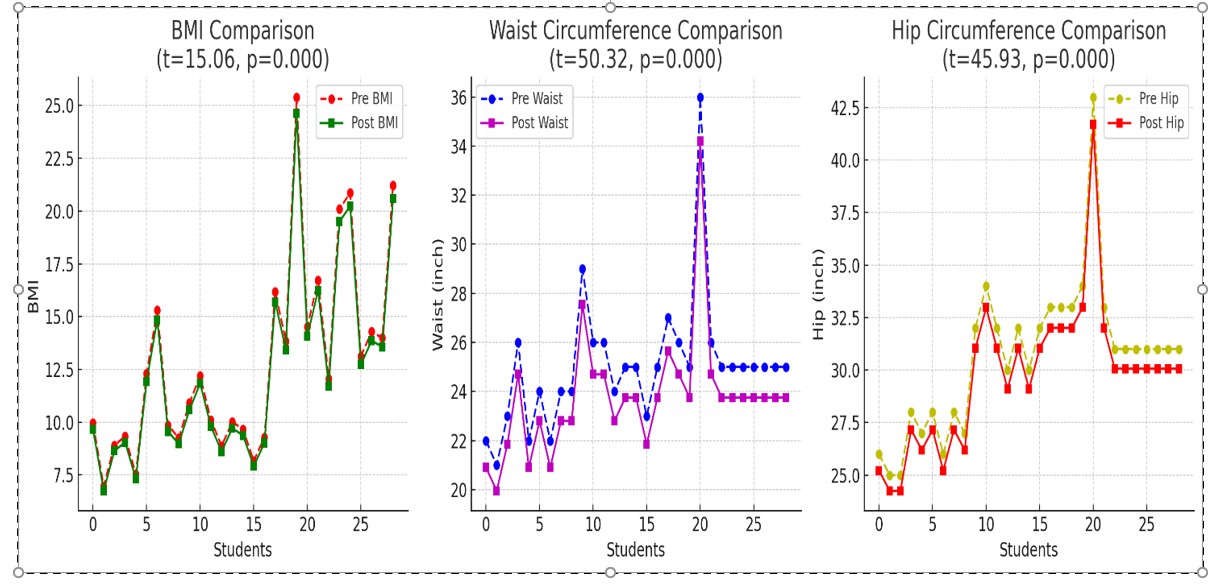Effect of Circuit Training on Body Composition Metrics among School Students
DOI:
https://doi.org/10.60081/SSHA.3.1.2025.435-439Keywords:
Circuit, BMI, waist, students, Obesity, trainingAbstract
Purpose: In recent times, students increasingly face problems related to being overweight, obese and under nutrition due to increasing screen time and sedentary lifestyle. The study aimed to analyze the effect of circuit training on body mass index and waist-hip ratio of school students. Material and Methods: An experimental research design was employed, involving 30 randomly selected students aged 10–15 years (20 boys and 10 girls). The selected group participated three days a week over a six-week circuit training intervention period. The statistical analysis was done using a paired simple t-test. Result: The findings of the present study reported a significant effect on body composition metrics following the circuit training program (p>0.05). Conclusion: training for 40 minutes three times a week for 6 weeks had a significant impact on the body composition metrics of school students.
References
Garg, R. K. (2025). The alarming rise of lifestyle diseases and their impact on public health: A comprehensive overview and strategies for overcoming the epidemic. Journal of Research in Medical Sciences, 30(1), 1.
Battista, F., Duregon, F., Vecchiato, M., Ermolao, A., & Neunhaeuserer, D. (2025). Sedentary lifestyle and physical inactivity: A mutual interplay with early and overt frailty. Nutrition, Metabolism and Cardiovascular Diseases, 103971.
Arena, R., & Cahalin, L. P. (2014). Evaluation of cardiorespiratory fitness and respiratory muscle function in the obese population. Progress in cardiovascular diseases, 56(4), 457-464.
Singh, S., Awasthi, S., Kapoor, V., & Mishra, P. (2023). Childhood obesity in India: a two-decade meta-analysis of prevalence and socioeconomic correlates. Clinical Epidemiology and Global Health, 23, 101390.
George, M., Dhull, S., Upadhyay, K., & Srivastava, S. S. (2024). Exploring body composition metrics: Comparing percentage body fat, BMI, and body fat mass in college students. Sports Science & Health Advances, 2(1), 210-215.
Kumar, D., & Dhull, K. N. S. (2023). A comprehensive analysis of circuit training: Assessing the benefits and drawbacks for diverse fitness goals. Journal of Sports Science and Nutrition, 4(1), 190-193.
Esan, J. A. (2018). Effect of circuit strength training programme on waist-to-hip ratio of college students. Kıbrıslı Eğitim Bilimleri Dergisi, 13(3), 340-348.
Sonchan, W., Moungmee, P., & Sootmongkol, A. (2017). The effects of a circuit training program on muscle strength, agility, anaerobic performance and cardiovascular endurance. World Academy of Science, Engineering and Technology, International Journal of Medical, Health, Biomedical, Bioengineering and Pharmaceutical Engineering, 11(4), 176–179.
Hermassi, S., Wollny, R., Schwesig, R., Shephard, R. J. and Chelly, M. S. 2019. Effects of InSeason Circuit Training on Physical Abilities in Male Handball Players. The Journal of Strength & Conditioning Research 33(4):944–957.
Paoli, A., Pacelli, F., Bargossi, A., Marcolin, G., Guzzinati, S., Neri, M., Bianco, A., & Palma, A. (2010). Effects of three distinct protocols of fitness training on body composition, strength and blood lactate. The Journal of sports medicine and physical fitness, 50 1, 43-51 .
Rahim, A.M., & Nasrulloh, A. (2025). The synergistic effects of circuit training and diet on weight loss, body fat percentage, and BMI in obese Indonesian females: a randomized controlled trial. Indonesian Journal of Research in Physical Education, Sport, and Health.
Smith, J., et al. (2019). Circuit training and its effects on metabolic rate and body composition. Journal of Exercise Science, 47(2), 112-123.
Plevková, L., & Peráčková, J. (2019). The effects of a 6-Week strength and endurance circuit training on body image of high school girls. Acta Facultatis Educationis Physicae Universitatis Comenianae, 59(2), 184–192.
Kim, J. W., Ko, Y. C., Seo, T. B., & Kim, Y. P. (2018). Effect of circuit training on body composition, physical fitness, and metabolic syndrome risk factors in obese female college students. Journal of exercise rehabilitation, 14(3), 460.
Kim, K. H., & Lee, H. B. (2019). Effects of circuit training interventions on bone metabolism markers and bone density of old women with osteopenia. Journal of exercise rehabilitation, 15(2), 302.
Nulhasan, N. A., & Mazalan, N. S. (2024). The effectiveness of circuit training on agility and body mass index among secondary school students in Putrajaya. International Journal of Social Science and Human Research, 7(05).

Downloads
Published
Issue
Section
License
Copyright (c) 2025 Nitesh Kumar Singh Kushwaha, Gajender Singh, Harsh Kumar Mathur, Amit, Siddharth Sagre, Ravinder Pal Ahlawat, Jaiprakash Bhukar

This work is licensed under a Creative Commons Attribution 4.0 International License.







